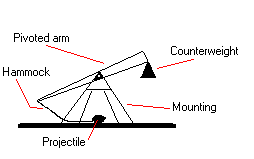

 edieval warfare consisted of other
things too besides knights dashing about and peasants getting killed in general.
One important feature was holding cities besieged. Some of the sieges lasted
pretty damn long, until the besieged city capitulated or the besiegers got
bored or were chased away. Sieges featured siege engines on both sides, as
an attack and a defensive weapon.
edieval warfare consisted of other
things too besides knights dashing about and peasants getting killed in general.
One important feature was holding cities besieged. Some of the sieges lasted
pretty damn long, until the besieged city capitulated or the besiegers got
bored or were chased away. Sieges featured siege engines on both sides, as
an attack and a defensive weapon.
 irst on the scene were catapults.
These were in effect large bows whose energy was derived from twisted ropes
or sinews. As a consequence, their effectiveness was modest at best, as many
castles such as Acre sported walls up to 6 metres
thick. The biggest catapults were able to hurl projectiles of 16 - 27 kilograms
to distances of some 180 metres. Stone projectiles did little harm to the
fortresses, but they did succeed well enough against unshielded humans.
irst on the scene were catapults.
These were in effect large bows whose energy was derived from twisted ropes
or sinews. As a consequence, their effectiveness was modest at best, as many
castles such as Acre sported walls up to 6 metres
thick. The biggest catapults were able to hurl projectiles of 16 - 27 kilograms
to distances of some 180 metres. Stone projectiles did little harm to the
fortresses, but they did succeed well enough against unshielded humans.
 nter the trebuchet. This contraption
was fully able to hurl projectiles weighing a thousand kilograms. That kind
of shots surely caused great havoc even in the sturdiest of structures. The
trebuchet is effectively a gigantic sling that uses the potential energy
of a raised counterweight to power its projectiles. A pivoted arm has the
counterweight at one end and the payload (if you could call it that) at the
other, connected to a rope hammock. When the trebuchet was fired, the weight
fell and the arm hurled the payload on a trajectory which most often ended
on some poor person's neck.
nter the trebuchet. This contraption
was fully able to hurl projectiles weighing a thousand kilograms. That kind
of shots surely caused great havoc even in the sturdiest of structures. The
trebuchet is effectively a gigantic sling that uses the potential energy
of a raised counterweight to power its projectiles. A pivoted arm has the
counterweight at one end and the payload (if you could call it that) at the
other, connected to a rope hammock. When the trebuchet was fired, the weight
fell and the arm hurled the payload on a trajectory which most often ended
on some poor person's neck.

 rebuchets reached the Mediterranean
from China in the late sixth century and became one of the favourite weapons
of the Arabs in their conquests. They were built both as stationary and mobile.
In the early models, the counterweight was not yet invented, or it was
supplemented by the joint pulling effort of up to a couple hundred people.
Invention of the said weight increased the range of the weapon consideraby,
and version 3.0 included a hinged counterweight that attained formidable
power. In the top-of-the-line models the counterweight was the size of a
peasant's hut, and weighed tens of tons. Such weapons are on record as having
thrown projectiles weighing 900 to 1360 kilograms. Not just stones were used,
dead horses were also considered useful ammo, as were bundled human corpses.
It was just the corpses of Mongols, dead of the Black Death, that helped
launch the famed epidemic in 1346 when the Mongols laid siege to Kaffa in
Constantinople.
rebuchets reached the Mediterranean
from China in the late sixth century and became one of the favourite weapons
of the Arabs in their conquests. They were built both as stationary and mobile.
In the early models, the counterweight was not yet invented, or it was
supplemented by the joint pulling effort of up to a couple hundred people.
Invention of the said weight increased the range of the weapon consideraby,
and version 3.0 included a hinged counterweight that attained formidable
power. In the top-of-the-line models the counterweight was the size of a
peasant's hut, and weighed tens of tons. Such weapons are on record as having
thrown projectiles weighing 900 to 1360 kilograms. Not just stones were used,
dead horses were also considered useful ammo, as were bundled human corpses.
It was just the corpses of Mongols, dead of the Black Death, that helped
launch the famed epidemic in 1346 when the Mongols laid siege to Kaffa in
Constantinople.
 more cheerful side note: trebuchets
contributed to the development of the word 'engineer'. In Latin vernacular,
the trebuchet was called ingenium, for ingenious contrivance, and
those who built them were called ingeniators, from whence 'engineer'
is just one step away. Detailed data on the trebuchet can be found in the
July 1995 issue of Scientific American, pages 58 to 63. The story
includes a hilarious sequence of pictures in which a modern reconstruction
of a trebuchet hurls a piano to a considerable distance at which it fails
to survive touchdown.
more cheerful side note: trebuchets
contributed to the development of the word 'engineer'. In Latin vernacular,
the trebuchet was called ingenium, for ingenious contrivance, and
those who built them were called ingeniators, from whence 'engineer'
is just one step away. Detailed data on the trebuchet can be found in the
July 1995 issue of Scientific American, pages 58 to 63. The story
includes a hilarious sequence of pictures in which a modern reconstruction
of a trebuchet hurls a piano to a considerable distance at which it fails
to survive touchdown.






